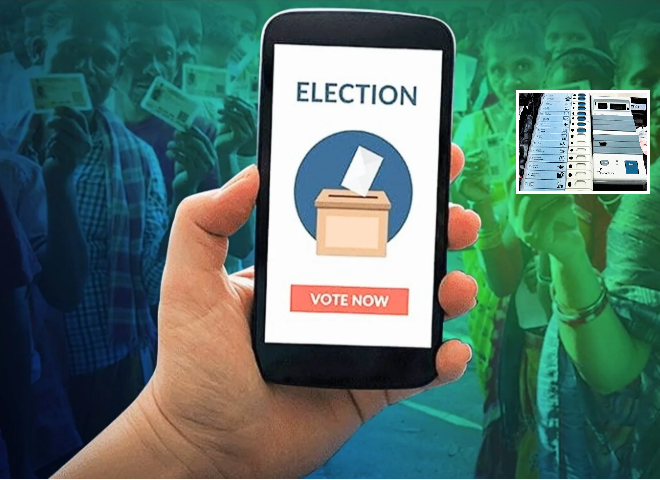
- In a groundbreaking step toward making governance more inclusive and participatory, Bihar has become the first Indian state to pilot mobile-based e-voting in its urban local body elections.
- The Digital India initiative, a transformative mission capable of making government services electronically available under the enhancement of online infrastructure and expansion of internet connectivity, became the formal expression of the journey of India towards digital governance since 2015.
- Since the 2014 general elections, India has experienced the emergence of highly professional digital campaigning.
- By expanding access, enhancing transparency, and empowering citizens across socio-economic and geographic divides, these initiatives strengthen the very foundation of participatory governance.
Democracy represents the foundation of a just society, where every individual, regardless of social or geographic position, is granted an equal voice. Initiatives such as digital voting serve as powerful examples of this ideal in action, extending participation to those historically excluded, including the elderly, migrant workers, and rural citizens. This advancement is not merely technological; it signifies a deeper commitment to equity, trust, and inclusion. By enabling broader access and reducing barriers, such efforts bring democratic principles closer to realisation. They reaffirm that democracy is not static, but a living, evolving system that must continuously strive to reach all.
In a groundbreaking step toward making governance more inclusive and participatory, Bihar has become the first Indian state to pilot mobile-based e-voting in its urban local body elections. Backed by the Election Commission of India and local administrative bodies, this initiative introduces a secure smartphone application that enables eligible voters—especially the youth, elderly, and migrant populations—to cast their votes without being physically present at polling stations. It is more than just a technical advancement; it is a gesture of trust toward citizens who are often left out of the electoral process due to systemic constraints.
As India rapidly urbanises and its digital footprint deepens, this pilot could serve as a national remote-voting model. With this, one could then conjure ideas for the bigger picture vis-a-vis digital democracy, wherein voting and other aspects of engagement between the state and its citizens are streamlined via the use of information and communications technologies (ICTs). The use of these digital platforms to open up participation in governance, ranging from online consultations, grievance redressal platforms, and real-time electoral information, is transforming. With Estonia leading the charge set forth by strong digital frameworks on a global scale, India, home to over 800 million internet users and close to 1 billion mobile connections, is looking at charting its destiny. The e-democracy movement signalled the awakening not merely to boost convenience, efficiency, or compatibility but to begin reimagining the social contract in a form where technology is the bridge to stronger, accountable, and inclusive democratic institutions.
The Digital India initiative, a transformative mission capable of making government services electronically available under the enhancement of online infrastructure and expansion of internet connectivity, became the formal expression of the journey of India towards digital governance since 2015. This initiative has transparent, efficient, and accessible ideals that directly pertain to the objective of e-governance to simplify administrative procedures and facilitate citizen-centric delivery of public services. From a democratic perspective, such a shift went into even more motion, considering the transformation between technology and electoral participation. Platforms such as MyGov, e-EPIC, C-Vigil, and Know Your Candidate (KYC) have gained prominence as major electoral interfaces through which citizens can now actively and securely participate in and stay aware of the electoral processes. Parallelly, the Election Commission of India(ECI) has also embarked upon a suite of landmark reforms to begin the process of modernisation of election management.
These activities suggest a purposeful attempt to make elections inclusive, tamper-resistant, and efficient-from the enormous deployment of Electronic Voting Machines (EVMs) and incorporation of Voter Verified Paper Audit Trail (VVPATs) to the piloting of remote voting systems and mobile-based voter registration. EVMs, introduced in the 1990s and made compulsory by 2004, transformed the very idea of casting and counting virtually, minimising human errors or malpractices. However, doubts were raised around their integrity, and public dialogue ensued with a demand for independent audits and technological safeguards. In response, VVPAT systems were introduced to increase confidence by providing the voter with visual evidence of their cast vote. The VVPATs were installed across the country during the 2019 general elections; however, technical malfunctions and limited audits have again sparked off debates to explore bigger transparency, more rigorous testing, and secure technologies such as blockchain. Together, these developments signify more than just administrative upgrades—they represent a broader commitment to strengthening the integrity and responsiveness of Indian democracy in the digital age.
In pursuit of eliminating voter fraud, the ECI proposed linking Aadhaar (India’s biometric ID system) with the electoral roll to curb duplicate and fraudulent entries. While this would clean up the voter databases and ensure accurate voter identification, it also results in grave privacy-related concerns. With no comprehensive data protection law in place, India opens up windows for illegal surveillance, coercion, and abuse of voter information. The debate is emblematic of the classic dilemma of efficiency vs. civil liberty in a digitised democracy. On the other hand, geospatial tools have been implemented for election planning, efficiency-mapping of polling stations, analysing voter density, and ensuring equitable resource allocation. Such tools allow for dynamism in planning according to demographics and geography based on real-time data, thus minimising errors in logistics and ensuring access. Further, digital platforms render several voter services, including locating their polling stations and providing voters with real-time election information, creating greater transparency.
India’s adoption of digital platforms has significantly changed its democratic landscape, altering not only how citizens vote but also their overall engagement with the electoral process. From simplifying voter registration through online portals to enabling secure access to digital voter ID cards via the e-EPIC platform, these initiatives have significantly enhanced convenience, particularly for tech-savvy youth and urban populations. Tools like C-Vigil empower citizens to report electoral violations in real time with geotagged evidence, while the Know Your Candidate (KYC) app fosters informed participation by offering detailed disclosures about candidates’ criminal histories, financial assets, and liabilities. Additionally, integrating the Right to Information (RTI) framework into digital governance has expanded transparency, allowing voters to file complaints, seek clarifications, and access public records with unprecedented ease.
The most significant transformation has occurred in the realm of political communication. Since the 2014 general elections, India has experienced the emergence of highly professional digital campaigning. The 2019 elections were dubbed the “WhatsApp Elections,” as they featured the strategic use of tens of thousands of WhatsApp groups to deliver micro-targeted messages. By 2024, election campaigning had further evolved into an AI-powered ecosystem, characterised by personalised voice messages in regional languages, data-driven voter profiling, and real-time performance monitoring. Centralised digital war rooms, staffed by thousands of tech professionals, now steer the narrative strategies of major political parties, testing slogans, analysing feedback loops, and tailoring outreach with surgical precision. The BJP’s deployment of over 900,000 “cell phone pramukhs” exemplifies this shift—mobilising volunteers to conduct hyper-localised engagement through mobile messaging platforms. While these innovations have expanded the reach and immediacy of political messaging, they also raise complex questions about data ethics, surveillance, and the line between persuasion and manipulation in a digital democracy.
India’s transition into a digitally empowered democracy presents an interesting opportunity by effectively bridging its rural-urban divide and ensuring that digital access amounts to true democratic inclusion. With the declining prices of smartphones and the fast expansion of mobile networks, BharatNet and Digital India projects have extended broadband connectivity to thousands of far-flung villages, entering them into the digital landscape for the first time. Alongside this connectivity push, digital literacy programs like PMGDISHA have imparted a digital orientation to millions, mostly from the marginalised sections and rural backgrounds, to navigate various online platforms, including those that deliver value to voters. By putting mass access and mass education alongside each other, the state has thus set into motion the creation of a confident electorate and informed citizenry residing at the margins and across socio-economic scales with enhanced participation in the electoral process. On the other front, technological innovations remove barriers to electoral inclusion of population groups traditionally relegated to the fringes of voting processes.
The advent of remote voting mechanisms and home-voting solutions–for example, the aforementioned mobile voting in Bihar–– makes way for flexible and dignified options for elderly, disabled, and migrant voters. The Election Commission’s commitment to inclusive design is evident in Braille-enabled EVMs, sign language awareness campaigns, and assisted voting booths. Furthermore, India’s linguistic diversity, once a barrier to digital participation, is being addressed through multilingual voter portals and election apps, now accessible in several Indian languages. Enhanced by intuitive user interfaces and visual-based navigation, these tools are increasingly accommodating users with low literacy levels or limited digital exposure.
In this light, the integration of digital technologies into India’s electoral processes is not merely a matter of modernisation—it is a reaffirmation of democratic values in action. By expanding access, enhancing transparency, and empowering citizens across socio-economic and geographic divides, these initiatives strengthen the very foundation of participatory governance. As India continues to evolve as a digital democracy, such efforts remind us that true democratic progress lies not only in innovation but in inclusion. It is through these sustained commitments that democracy moves from principle to practice, becoming a lived experience for every citizen, not just a constitutional promise.
Alok Virendra Tiwari is a political science graduate from Mumbai University, experienced with the National Commission for Scheduled Tribes, Y20, and the World Food Forum. He is currently working as the Program Manager and Instructional Delivery in the office of Vice-Chancellor at Rishihood University.
